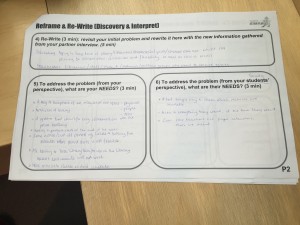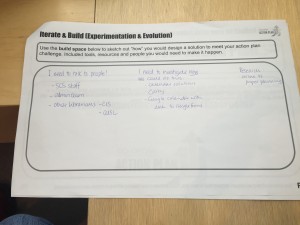Following on from my last post, I’ve taken some time to consider my action plan, think about what my needs really are, and think more carefully about the process. This post will consider the Design Thinking process we undertook at The York School in November, and help me work through my thoughts as we come to the end of our first term in Cohort 21.
Discovery:
We were asked to think about some problems / challenges / opportunities you or your students are currently experiencing in your practice. EASY! We have lots of issues we face each day that challenge all the different user groups we have in the library. But on that cold November day, something that was front of mind for me was scheduling.
One aspect of this part of the Design Thinking Process that really got me thinking was the interview with my partner. As I described my problem to someone else, and formalized my thinking, new ideas started popping into my head. Further, as I shared around the table, I found a variety of responses; some teachers couldn’t understand why the collaboration piece was so important to us as librarians; others talked about convenience as being the main goal. It was a good reminder to keep ALL of our users’ needs in mind as we continued.
Discovery & Interpret:
We re-visited our initial thoughts to redefine our problem, and see it from others’ point of view. The guiding questions were excellent for garnering an empathetic response.
Ideate aka Crazy 8s:
Whilst all aspects of the Design Thinking Process are a challenge to me as a linear thinker, Crazy 8s is the hardest! To come up with eight ideas in a limited amount of time is really difficult for me; I don’t think of myself as a creative person, and balked at the suggestion of using drawings instead of words. Anyway, in the spirit of all things Cohort I DID manage to come up with eight potential ideas, but it was hard!
I found the partner feedback for this section useful, particularly when it came to telling me which ideas probably wouldn’t work.
Ideation & Consolidation:
Taking all of my ideas, and the feedback received thus far, it wasn’t too difficult to come up with a How Might We… question.
These questions were subsequently posted in a gallery walk, and all participants were invited to submit their ideas / thoughts / suggestions to each posted How Might We question… Thanks to all to made suggestions on my question!
Iterate & Build
So, after digesting all of the suggestions and comments, I started to make an action plan of WHO I needed to talk to, WHAT I needed to find out, and the RESEARCH I need to start doing…
So, action plan chosen! But I found it really difficult to blog about the process straight after we did it; it’s taken more than two weeks for me to consider my plan, my school and my goals. I presented at a staff meeting last week, along with @adamcaplan and @lmustard, and the feedback I’ve had from staff already is quite encouraging and insightful. However, I think I’ve committed a grave Design Thinking error. I think I’d decided on the solution to my problem BEFORE even starting the process, and it has shaped and influenced my thinking. I need to work at investigating other solutions too, however, and not just focusing on the one I currently believe to be the best (or only).
I’m looking forward to taking some time over the next few weeks as school winds down to research planning and scheduling. As a librarians, researching is often my favourite part of any task, and I’m fully aware it’s one that I can get totally lost in whilst losing sight of my end goal. I’m looking forward to coming together again as a group at our third Face 2 Face session in January, and sharing what I’ve learned along the way…






This is a great process, Claire. Let me know how I can help in the ideation and questioning phases as you consider all alternatives.
Thanks, Peter!
Clare, I really appreciate your honesty about how you came to the design thinking process with a clear solution in your head and how this framed your thinking around the day. I think this is probably true for many people (you were just brave enough to name it).
And that’s not to say that your original solution isn’t a fantastic solution! It is clear that you fully engaged with this process, so even if you have other ideas now floating around, you may just be able to modify or tweak your original plan to incorporate the best suggestions from the last F2F…or just be comforted in the fact that you had a great solution to begin with.
In other words, it’s all good.
Thanks for the very thorough run down of the design thinking day: this would be a great post to share with participants next year before they start this process!
Thanks, Celeste. I am not sure it is the best solution! I am looking forward to investigating some other possibilities before we meet for our next F2F session…
What stands out to me Claire in your blog post, is the very important role your CIS Ontario colleagues played in helping you delineate your plan at our last F2F. “Who” and “What” seem to be resolved somewhat…keep up the great work!
Thanks, Jan – I’ve met so many inspiring people through Cohort 21!
Hi Claire,
One thing that strikes me about the problem you identify is that problems never exist in a vacuum. There’s always a current solution that requires sustaining and will eventually need to be ‘decommissioned’ as one implements or trials any new solution. You currently do an excellent job of providing the support bridge between teachers/students and the booking systems. It always feels like service with a smile – a “yes” whenever possible.
🙂